If the diagonals of a parallelogram are equal, then show that it is a rectangle.
Answer
Let ABCD be a parallelogram with equal diagonals.

From figure,
In ∆ ABC and ∆ DCB,
⇒ AB = DC (Opposite sides of a parallelogram are equal)
⇒ BC = BC (Common side)
⇒ AC = DB (Diagonals of parallelogram are equal)
∴ ∆ ABC ≅ ∆ DCB (By S.S.S. Congruence rule)
We know that,
Corresponding parts of congruent triangles are equal.
⇒ ∠ABC = ∠DCB (By C.P.C.T.) ......(1)
We know that,
Sum of co-interior angles equal to 180°.
⇒ ∠ABC + ∠DCB = 180° (AB || CD)
⇒ ∠ABC + ∠ABC = 180° [From equation (1)]
⇒ 2∠ABC = 180°
⇒ ∠ABC =
⇒ ∠ABC = ∠B = 90°
⇒ ∠DCB = ∠C = 90°
Since,
Opposite angles of parallelogram are equal.
∴ ∠D = ∠B = 90° and ∠A = ∠C = 90°.
∴ ∠B = ∠D = ∠C = ∠A = 90°.
Since, opposite sides of ABCD are equal in length and each interior angle equals to 90°.
Hence, proved that if the diagonals of a parallelogram are equal, then it is a rectangle.
Show that the diagonals of a square are equal and bisect each other at right angles.
Answer
Let ABCD be the square.
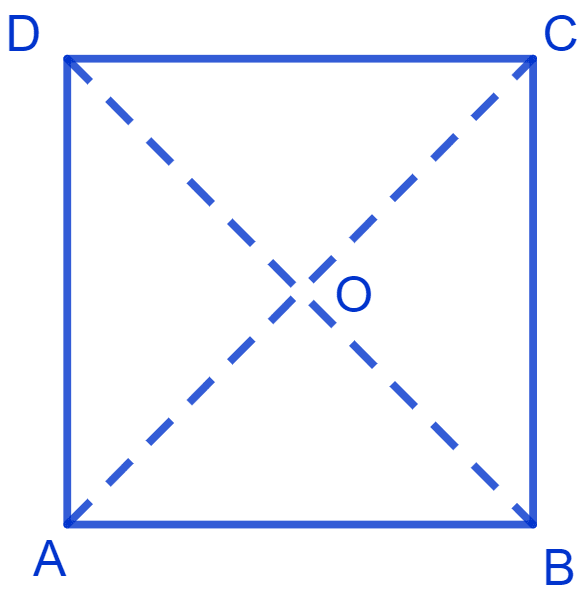
In Δ ABC and Δ BAD,
⇒ AB = AB (Common side)
⇒ BC = AD (Each side of a square is equal in length)
⇒ ∠ABC = ∠BAD = 90° (Each interior angle in a square is a right angle)
∴ Δ ABC ≅ Δ BAD (By S.A.S. congruence rule)
We know that,
Corresponding parts of congruent triangles are equal.
∴ AC = BD (By C.P.C.T.)
In Δ OAD and Δ OCB,
⇒ AD = CB (Each side of a square is equal in length)
⇒ ∠OAD = ∠OCB (Alternate angles are equal)
⇒ ∠ODA = ∠OBC (Alternate angles are equal)
∴ Δ OAD ≅ Δ OCB (By A.S.A. congruence rule)
We know that,
Corresponding parts of congruent triangles are equal.
⇒ OA = OC (By C.P.C.T.) ......(1)
⇒ OB = OD (By C.P.C.T.) .....(2)
In Δ OBA and Δ ODA,
⇒ OB = OD ....[From equation (2)]
⇒ OA = OA (Common side)
⇒ BA = DA (Each side of a square is equal in length)
∴ Δ OBA ≅ Δ ODA (By S.S.S. congruence rule)
We know that,
Corresponding parts of congruent triangles are equal.
⇒ ∠AOB = ∠AOD = x (let) (By C.P.C.T.)
⇒ ∠AOB + ∠AOD = 180° (Linear pair)
⇒ x + x = 180°
⇒ 2x = 180°
⇒ x = = 90°.
⇒ ∠AOB = 90° and ∠AOD = 90°.
Thus, AC and BD bisect each other at right angles.
Hence, proved that the diagonals of a square are equal and bisects each other at right angles.
Diagonal AC of a parallelogram ABCD bisects ∠A. Show that
(i) it bisects ∠C also,
(ii) ABCD is a rhombus.
(Ex.8.1Q3.png)
Answer
(i) We know that,
ABCD is a parallelogram.
So, opposite sides are parallel and equal.
⇒ ∠DAC = ∠BCA (Alternate interior angles are equal) ......(1)
⇒ ∠BAC = ∠DCA (Alternate interior angles are equal) .......(2)
Given,
⇒ AC bisects ∠A
⇒ ∠DAC = ∠BAC .......(3)
From equations (1), (2), and (3), we get :
⇒ ∠DCA = ∠BAC = ∠DAC = ∠BCA .........(4)
∴ ∠DCA = ∠BCA
∴ AC bisects ∠C.
Hence, proved that AC bisects ∠C.
(ii) In Δ ABC,
⇒ ∠BAC = ∠BCA (Proved above)
⇒ BC = AB (Side opposite to equal angles are equal) .....(5)
⇒ DA = BC and AB = CD (Opposite sides of a parallelogram are equal) ....(6)
From equations (5) and (6), we get :
⇒ AB = BC = CD = DA.
Since, all sides of quadrilateral ABCD are equal.
Hence, proved that ABCD is a rhombus.
ABCD is a rectangle in which diagonal AC bisects ∠A as well as ∠C. Show that :
(i) ABCD is a square
(ii) diagonal BD bisects ∠B as well as ∠D.
Answer
Rectangle ABCD is shown in the figure below:

(i) Given :
ABCD is a rectangle and AC bisects ∠A and ∠C.
⇒ ∠DAC = ∠CAB ....(1)
⇒ ∠DCA = ∠BCA .....(2)
We know that,
Opposite sides of a rectangle are parallel and equal.
From figure,
AD || BC and AC is transversal,
⇒ ∠DAC = ∠BCA ..........(3) (Alternate interior angles are equal)
From equations (1) and (3), we get :
⇒ ∠CAB = ∠BCA ......(4)
In △ ABC,
⇒ ∠CAB = ∠BCA
We know that,
Sides opposite to equal angles are equal.
⇒ BC = AB .....(5)
We know that,
Opposite sides of a rectangle are equal.
⇒ BC = AD .........(6)
⇒ AB = DC .........(7)
From equation (5), (6) and (7), we get :
⇒ AB = BC = CD = AD.
Since,
ABCD is a rectangle and all the sides are equal. Hence, ABCD is a square.
Hence, proved that ABCD is a square.
(ii) Join BD.
In Δ BCD,
⇒ BC = CD (Sides of a square are equal to each other)
⇒ ∠CDB = ∠CBD (Angles opposite to equal sides are equal) ..... (8)
⇒ ∠CDB = ∠ABD (Alternate interior angles are equal) ..... (9)
From equations (8) and (9), we get :
⇒ ∠CBD = ∠ABD
∴ BD bisects ∠B.
From figure,
⇒ ∠CBD = ∠ADB (Alternate interior angles are equal) .....(10)
From equations (8) and (10), we get :
⇒ ∠ADB = ∠CDB
∴ BD bisects ∠D.
Hence, proved that diagonal BD bisects ∠B as well as ∠D.
In parallelogram ABCD, two points P and Q are taken on diagonal BD such that DP = BQ see Fig. Show that:
(i) Δ APD ≅ Δ CQB
(ii) AP = CQ
(iii) Δ AQB ≅ Δ CPD
(iv) AQ = CP
(v) APCQ is a parallelogram
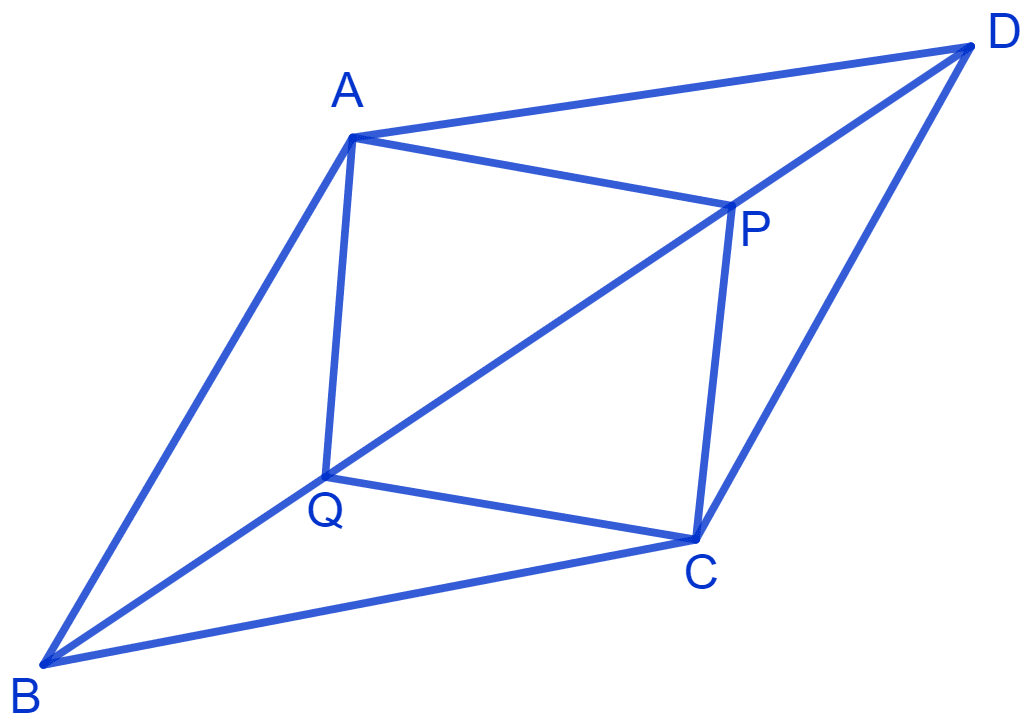
Answer
Given :
ABCD is a parallelogram.
From figure,
AD || BC and BD is transversal
⇒ ∠ADP = ∠CBQ (Alternate angles are equal)
(i) In Δ APD and Δ CQB,
⇒ AD = CB (Opposite sides of parallelogram ABCD are equal)
⇒ DP = BQ (Given)
⇒ ∠ADP = ∠CBQ (Proved above)
∴ Δ APD ≅ Δ CQB (By S.A.S. congruence rule)
Hence, proved that Δ APD ≅ Δ CQB.
(ii) In Δ APD ≅ Δ CQB,
We know that,
Corresponding parts of congruent triangles are equal.
⇒ AP = CQ (By C.P.C.T.) ........(1)
Hence, proved that AP = CQ.
(iii) In Δ AQB and Δ CPD,
⇒ AB = CD (Opposite sides of parallelogram ABCD are equal)
⇒ ∠ABQ = ∠CDP (Alternate interior angles are equal)
⇒ BQ = DP (Given)
⇒ Δ AQB ≅ Δ CPD (By S.A.S. congruence rule)
Hence, proved that Δ AQB ≅ Δ CPD.
(iv) Since Δ AQB ≅ Δ CPD,
We know that,
Corresponding parts of congruent triangles are equal.
⇒ AQ = CP (C.P.C.T.) ............(2)
Hence, proved that AQ = CP.
(v) From equation (1) and (2), we get :
⇒ AQ = CP and AP = CQ
Since both pairs of opposite sides in APCQ are equal,
Hence, proved that APCQ is a parallelogram.
ABCD is a parallelogram and AP and CQ are perpendiculars from vertices A and C on diagonal BD. Show that
(i) Δ APB ≅ Δ CQD
(ii) AP = CQ
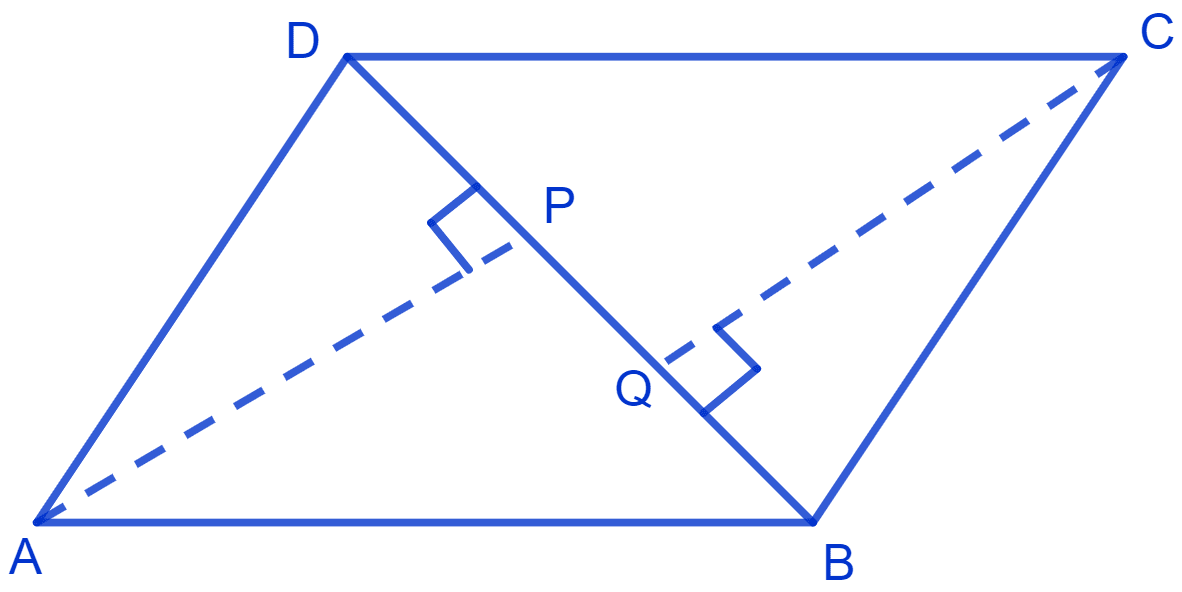
Answer
Given :
ABCD is a parallelogram with AP ⊥ BD and CQ ⊥ BD.
From figure,
AB || DC and BD is transversal.
(i) In Δ APB and Δ CQD,
⇒ ∠APB = ∠CQD (Both equal to 90°)
⇒ AB = CD (Opposite sides of parallelogram are equal)
⇒ ∠ABP = ∠CDQ (Alternate interior angles are equal)
∴ Δ APB ≅ Δ CQD (By A.A.S. congruence rule)
Hence, proved that Δ APB ≅ Δ CQD.
(ii) Since,
Δ APB ≅ Δ CQD
We know that,
Corresponding parts of congruent triangles are equal.
⇒ AP = CQ (By C.P.C.T.)
Hence, proved that AP = CQ.
ABCD is a trapezium in which AB || CD and AD = BC. Show that
(i) ∠A = ∠B
(ii) ∠C = ∠D
(iii) Δ ABC ≅ Δ BAD
(iv) diagonal AC = diagonal BD
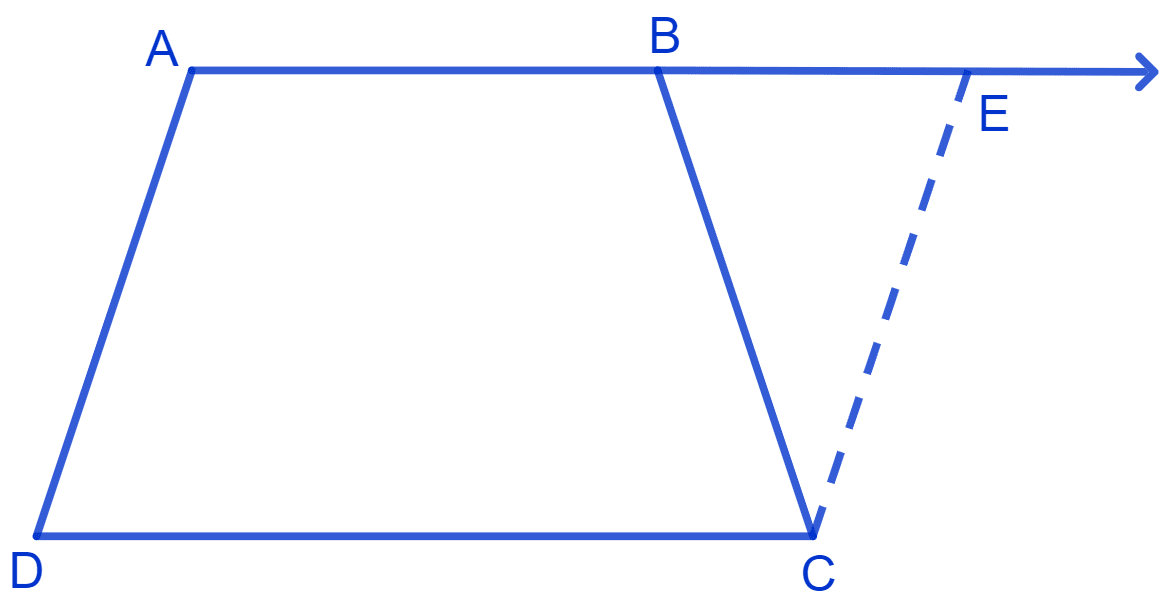
Answer
Steps of construction :
Extend AB.
Draw a line through C parallel to DA intersecting AB produced at E.
Given :
ABCD is a trapezium, AB || CD and AD = BC
By construction,
AD || CE
and
AE || DC.
In AECD, both pair of opposite sides are parallel, hence, AECD is a parallelogram
(i) From figure,
AD = CE (Opposite sides of parallelogram are equal)
As,
AD = BC
∴ BC = CE
We know that,
Angles opposite to equal sides in a triangle are also equal.
⇒ ∠CEB = ∠CBE .........(1)
Consider, parallel lines AD and CE where AE is the transversal.
We know that,
Sum of co-interior angles = 180°
⇒ ∠BAD + ∠CEB = 180°
⇒ ∠BAD + ∠CBE = 180° [From equation (1)] ..... (2)
From figure,
⇒ ∠ABC + ∠CBE = 180° (Linear pairs) ....... (3)
From equations (2) and (3), we get :
⇒ ∠BAD + ∠CBE = ∠ABC + ∠CBE
⇒ ∠BAD = ∠ABC.
∴ ∠A = ∠B
Hence, proved that ∠A = ∠B.
(ii) From figure,
AB || CD
We know that,
Sum of co-interior angles equal to 180°.
⇒ ∠A + ∠D = 180° .........(4)
⇒ ∠C + ∠B = 180° .........(5)
From equation (4) and (5), we get :
⇒ ∠A + ∠D = ∠C + ∠B
Since, ∠A = ∠B
We can say that,
⇒ ∠D = ∠C
Hence, proved that ∠C = ∠D.
(iii) Join AC and BD.
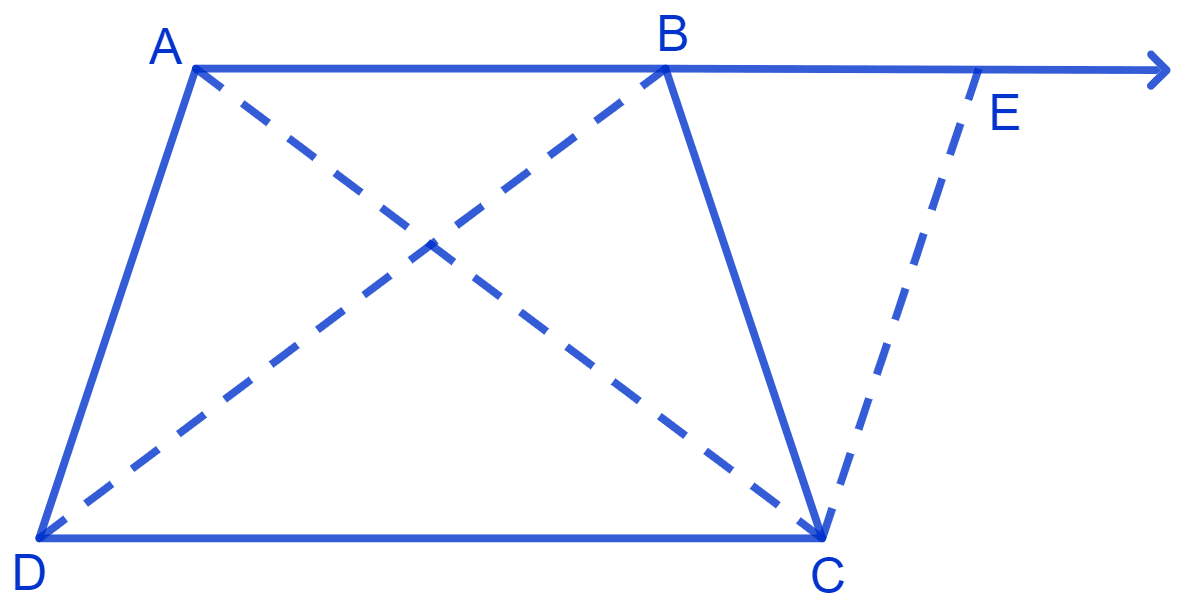
In ∆ ABC and ∆ BAD,
⇒ AB = BA (Common side)
⇒ BC = AD (Given)
⇒ ∠B = ∠A (above)
∴ ∆ ABC ≅ ∆ BAD (By S.A.S. congruence rule)
Hence, proved that Δ ABC ≅ Δ BAD.
(iv) Since ∆ ABC ≅ ∆ BAD,
We know that,
Corresponding parts of congruent triangles are equal.
⇒ AC = BD (By C.P.C.T.)
Hence, proved that diagonal AC = diagonal BD.
ABCD is a quadrilateral in which P, Q, R and S are mid-points of the sides AB, BC, CD and DA. AC is a diagonal. Show that :
(i) SR || AC and SR =
(ii) PQ = SR
(iii) PQRS is a parallelogram

Answer
Given :
ABCD is a quadrilateral, where P, Q, R and S are the mid points of the sides AB, BC, CD and DA.
Mid-point theorem : The line segment joining the mid-points of any two sides of the triangle is parallel to the third side and is half of it.
(i) In △ ADC,
S and R are the mid-points of side AD and CD respectively.
By mid-point theorem,
⇒ SR || AC .......(1)
⇒ SR = ......(2)
Hence, proved that SR || AC and SR = .
(ii) In Δ ABC, P and Q are mid-points of sides AB and BC.
By using the mid-point theorem,
⇒ PQ || AC .........(3)
⇒ PQ = ......(4)
From equations (3) and (4), we get :
⇒ PQ = SR
Hence, proved that PQ = SR.
(iii) From equation (1) and (3), we get :
⇒ PQ || AC || SR
⇒ PQ || SR
Also,
⇒ PQ = SR (Proved above)
We know that,
If one pair of opposite sides are equal and parallel, then the figure is parallelogram.
Hence, proved that PQRS is a parallelogram.
ABCD is a rhombus and P, Q, R and S are the mid-points of the sides AB, BC, CD and DA respectively. Show that the quadrilateral PQRS is a rectangle.
Answer
In Δ ABC,
P and Q are mid points of AB and BC

By mid-point theorem,
PQ || AC and PQ = .....(1)
In Δ ADC,
S and R are mid points of AD and DC.
By mid-point theorem,
⇒ SR || AC and SR = .....(2)
From equations (1) and (2), we get :
⇒ SR = PQ and SR || PQ.
Since, one of the opposite pairs of PQRS are parallel and equal.
∴ PQRS is a parallelogram.
Let the diagonals AC and BD intersect at O.
In Δ BAC,
P and Q are mid points of AB and BC.
By mid-point theorem,
PQ || AC and PQ =
∴ MQ || ON
In Δ BCD,
Q and R are mid points of BC and CD.
By mid-point theorem,
QR || BD and QR =
∴ QN || OM
Since, opposite sides of quadrilateral OMQN are parallel.
∴ OMQN is a parallelogram
⇒ ∠MQN = ∠NOM (Opposite angles of parallelogram are equal)
We know that,
Diagonals of rhombus intersect at 90°
∴ ∠NOM = 90°
⇒ ∠PQR = ∠NOM = 90°
So, ∠PQR = 90°
In PQRS,
One pair of opposite side is parallel and equal and one of its interior angle is 90°.
Hence, proved that PQRS is a rectangle.
ABCD is a rectangle and P, Q, R and S are mid-points of the sides AB, BC, CD and DA respectively. Show that the quadrilateral PQRS is a rhombus.
Answer
We know that,
The diagonals of a rectangle are equal.
⇒ BD = AC = x (let)

In △ ABC,
P and Q are the mid-points of AB and BC respectively.
By mid-point theorem,
⇒ PQ || AC and PQ = ....(1)
In △ ADC,
S and R are the mid-points of AD and CD respectively.
SR || AC and SR = .....(2)
From equation (1) and (2), we get :
PQ || SR and PQ = SR
In quadrilateral PQRS, one pair of opposite sides are equal and parallel to each other.
∴ PQRS is a parallelogram.
In △ BCD, Q and R are the mid-points of side BC and CD respectively.
By mid-point theorem,
⇒ QR || BD and QR = ....(3)
In △ BAD, P and S are the mid-points of side AB and AD respectively.
By mid-point theorem,
PS || BD and PS = .......(4)
From equations (1), (2), (3), (4), we get :
PQ = QR = SR = PS
Hence, proved that the quadrilateral PQRS is a rhombus.
ABCD is a trapezium in which AB || DC, BD is a diagonal and E is the mid-point of AD. A line is drawn through E parallel to AB intersecting BC at F see Fig. Show that F is the mid-point of BC.

Answer
Given :
ABCD is a trapezium, where AB || DC, E is the mid-point of AD and EF || AB.
By converse of mid-point theorem,
A line drawn through the mid-point of any side of a triangle and parallel to another side bisects the third side.
Let EF intersect BD at point G.

In trapezium ABCD,
EF || AB and E is the mid-point of AD.
By converse of mid-point theorem,
G is the mid-point of DB
As, EF || AB and AB || CD,
EF || CD (Two lines parallel to the same line are parallel to each other)
In Δ BCD,
GF || CD and G is the mid-point of line BD.
By using the converse of mid-point theorem, F is the mid-point of BC.
Hence, proved that F is the mid-point of BC.
In a parallelogram ABCD, E and F are the mid-points of sides AB and CD respectively see Fig. Show that the line segments AF and EC trisect the diagonal BD.

Answer
Given :
ABCD is a parallelogram, where E and F are the mid-points of sides AB and CD.
We know that,
Opposite sides of a parallelogram are equal and parallel.
∴ AB || CD and AB = CD
∴ AE || FC
Since, AB = CD
Dividing both sides of equation by 2, we get :
⇒ =
⇒ AE = FC
∴ AEFC is a parallelogram.
∴ AF || CE
From figure,
⇒ PF || QC
⇒ EQ || AP
In △ DQC,
F is the mid-point of DC and FP || CQ.
By converse of mid-point theorem, we get :
P is the mid-point of DQ.
⇒ DP = PQ .....(1)
In △ APB,
E is the mid-point of AB and EQ || AP.
By converse of mid-point theorem, we get :
Q is the mid-point of BP.
⇒ PQ = QB ......(2)
From equations (1) and (2) we get :
⇒ PQ = QB = DP.
∴ AF and EC trisect BD.
Hence, proved that AF and EC trisect the diagonal BD.
ABC is a triangle right angled at C. A line through the mid-point M of hypotenuse AB and parallel to BC intersects AC at D. Show that
(i) D is the mid-point of AC
(ii) MD ⊥ AC
(iii) CM = MA =
Answer
(i) In Δ ABC,
It is given that M is the mid-point of AB and MD || BC.

By converse of mid-point theorem, we get :
Thus, D is the mid-point of AC.
Hence, proved that D is the mid-point of AC.
(ii) As DM || CB and AC is a transversal,
We know that,
Sum of co-interior angles = 180°.
⇒ ∠MDC + ∠DCB = 180°
⇒ ∠MDC + 90° = 180°
⇒ ∠MDC = 180° - 90°
⇒ ∠MDC = 90°
Hence, proved that MD ⊥ AC.
(iii) Join MC,
In Δ AMD and Δ CMD,
⇒ AD = CD (D is the mid-point of side AC)
⇒ ∠ADM = ∠CDM (Since, MD ⊥ AC)
⇒ DM = DM (Common side)
∴ Δ AMD ≅ Δ CMD (By S.A.S. congruence rule)
We know that,
Corresponding parts of congruent triangles are equal.
⇒ AM = CM (By C.P.C.T.)
We know that,
M is the mid-point of AB.
∴ AM =
⇒ CM = AM = .
Hence, proved that CM = MA = .